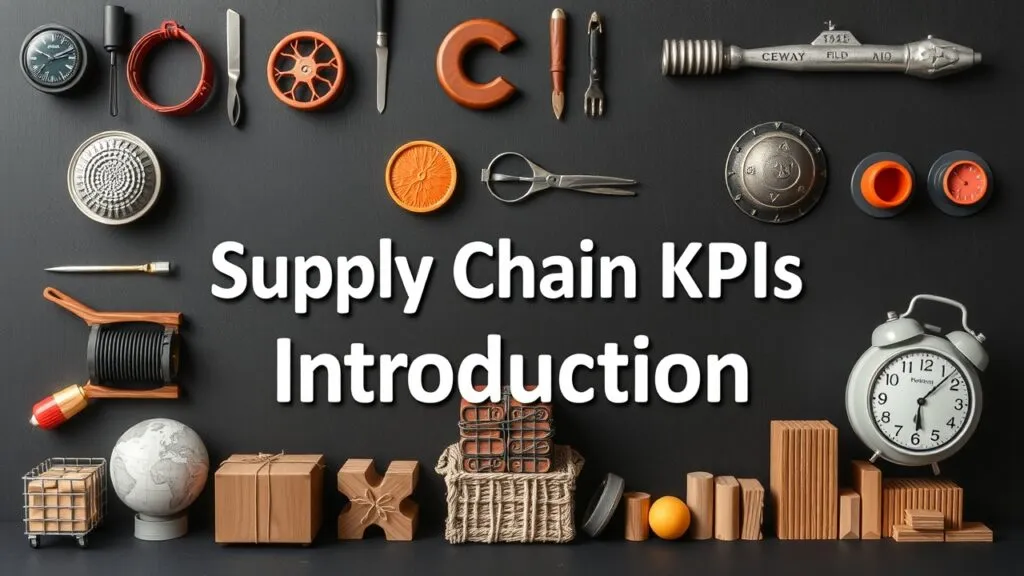This guide covers types of supply chain KPIs like inventory and on-time delivery, helping you improve efficiency and achieve better business results by measuring logistics success. Understanding these metrics is vital for improving overall performance and reducing supply chain risk.
What Are Supply Chain KPIs?

Supply chain Key Performance Indicators (KPIs) are clear and measurable values. They help businesses check how well they are meeting their goals in the supply chain. These indicators show details about supply chain management, like efficiency, quality, and customer satisfaction. When companies look at these metrics, they can find areas that need fixing and make better decisions.
It’s really important to measure performance at each stage of the supply chain. This helps managers spot problems and improve processes. For example, if delivery times are tracked, it can show where things are slowing down in logistics or if there are issues with suppliers. Keeping an eye on inventory turnover rates also helps businesses manage stock better while keeping costs down.
Why Are Supply Chain Metrics Essential for Success?
Using supply chain metrics comes with many benefits that can lead to business success. First off, KPIs help companies find inefficiencies in their operations. By looking at specific metrics like order accuracy or lead time variability, businesses can make processes smoother and improve operational efficiency.
Effective use of KPIs can also boost profitability. When companies see which areas need work—like reducing excess inventory or improving transportation routes—they can create focused strategies that save costs and increase revenue.
But if organizations ignore KPIs or just focus on one type, they face big risks. They might miss important performance gaps if they don’t keep track of a balanced set of indicators throughout the supply chain. This oversight could mean lost chances for improvement and hurt their competitiveness in the market.
Understanding what supply chain KPIs are is crucial for any organization that wants to work better and achieve lasting success.
Categories and Types of Supply Chain KPIs
Inventory Management Metrics Explained
Inventory management is super important for keeping supply chains running smoothly. Businesses use key performance indicators (KPIs) to see how well they control stock levels. This helps ensure products are ready when needed, without having too much on hand.
- Inventory Turnover Rate: This shows how often a company sells and replaces its inventory over time. A high turnover means good management, while a low turnover might mean there’s too much stock or poor sales.
- Stockout Rate: This measures how often items are out of stock. If this number is high, it can mean lost sales and unhappy customers. It points out where inventory levels need to change.
- Days Sales of Inventory (DSI): DSI tells how many days it takes to sell through all inventory. A lower DSI generally means better inventory management practices.
- Inventory Holding Costs: These costs include storage fees, insurance, and other expenses related to keeping unsold goods. Keeping track of these costs helps businesses make better inventory choices.
- Fill Rate: The fill rate shows the percentage of customer orders that get fulfilled on time from stock without any backorders or delays. High fill rates show strong performance in operations.
These metrics give clear insights into overall supply chain performance by highlighting what’s working well and what needs improvement in managing inventories effectively.
Procurement Metrics Overview
Procurement KPIs help businesses evaluate their relationships with suppliers and how they manage purchases:
- On-Time Delivery Rate from Suppliers: This tracks how often suppliers deliver materials on time—critical for avoiding production delays.
- Purchase Order Cycle Time: This measures the time taken from placing an order to receiving goods, offering insight into how efficient procurement processes are; shorter times suggest more streamlined processes.
- Supplier Performance Metrics: Assessing suppliers based on quality, delivery reliability, cost competitiveness, and responsiveness ensures companies work with reliable vendors who meet expectations regularly.
- Procurement Cost as a Percentage of Revenue: Knowing what portion of revenue goes toward procurement helps companies understand their spending compared to income generated from sales.
By regularly analyzing these procurement metrics, organizations can improve collaboration with suppliers while reducing costs across their operations.
Manufacturing/Production Metrics Breakdown
Manufacturing KPIs focus on measuring production efficiency and quality during the manufacturing process:
- Production Efficiency: This shows the actual output compared to potential maximum output under ideal conditions; higher percentages indicate better use of resources like labor or machinery.
- Defect Rate: Tracking defects per unit produced helps manufacturers find problems affecting quality early; lower defect rates lead to happier customers.
- Capacity Utilization Rate: This metric measures actual output versus total capacity available during a set period, helping firms know if they’re using resources efficiently.
- Overall Equipment Effectiveness (OEE): OEE looks at availability due to downtime losses, speed loss, and quality loss from defective units produced—it’s key for understanding equipment productivity fully.
- Production Cycle Time: This calculates the total time needed—from getting raw materials to shipping finished goods—helping spot bottlenecks that slow down delivery times across manufacturing stages.
Logistics & Delivery Metrics Insights
Logistics KPIs assess transportation efficiency that’s vital for meeting customer demands quickly:
- Freight Costs as a Percentage of Revenue: Analyzing shipping costs compared to revenues reveals where logistics can improve and save money overall.
- Perfect Order Rate: This metric measures successful fulfillment where orders are delivered accurately, intact, on-time, and complete; higher scores reflect strong logistical capabilities that support business goals efficiently.
- Order Fulfillment Cycle Time: Measuring the time from order placement until delivery highlights process efficiencies that allow businesses to identify areas needing improvement for faster service.
- Customer Order Lead Time: This checks the time needed to fulfill customer requests providing insight into how responsive a business is and allowing proactive adjustments for timely service delivery.
Customer Service Performance Indicators
Customer satisfaction drives repeat purchases and positive brand loyalty:
- Net Promoter Score (NPS): NPS measures how likely customers are to recommend services or products based on their experience; it reflects perceived value and fosters long-term relationships built on trust.
- Return Rates: Monitoring return rates helps businesses understand why customers might be unhappy so they can fix those issues before they happen again.
- On-Time In-Full (OTIF) Rate: This metric checks the percentage of orders shipped accurately while fulfilling all specified requirements; it shows how well communication is handled throughout transactions.
- Service Level: This establishes whether commitments made regarding response times or resolving issues are being met; it helps assess an organization’s dedication to delivering great customer experiences consistently across all interactions.
Leading vs Lagging Indicators in Supply Chains
What Are Leading Indicators?
Leading indicators are key metrics that help companies forecast future supply chain performance. They provide insights into what might happen down the road. A great example is supplier lead time forecasting. By looking at past data, businesses can predict how long it will take for suppliers to deliver goods later on. This use of predictive analytics aids in managing inventory and anticipating demand effectively.
Other common leading indicators include:
- Order backlog levels
- Production schedules
- Customer inquiries about product availability
These metrics help supply chain managers spot potential changes in demand or supply disruptions early on. This proactive approach boosts overall supply chain performance.
Understanding Lagging Indicators
Lagging indicators, on the other hand, focus on past performance and results. They show what has already happened instead of predicting future trends. One important lagging indicator is delivery accuracy rates, which measure how often orders arrive on time and complete as promised.
These indicators are vital for measuring performance because they highlight areas needing improvement after issues have occurred. Other examples include:
- Return rates
- Average shipping times
- Order fulfillment KPIs
By examining these metrics, organizations can evaluate their operational efficiency based on what’s already happened.
How Both Types Work Together to Provide Holistic Data?
Using both leading and lagging indicators gives a fuller picture of supply chain operations. Leading indicators allow businesses to make decisions based on predictions, while lagging indicators give feedback on how past actions worked out.
This combination leads to better data analysis, improving supply chain visibility by spotting trends over time. For instance, if a company sees rising lead times (a leading indicator), it can check its supplier relationships or logistics before facing major delays (lagging outcome).
Effectively using both types of KPIs can help companies make data-driven decisions that increase profits while reducing risks from unexpected challenges.
Deep Dive into Inventory Management KPIs
Inventory Turnover Rate
The inventory turnover rate tells us how often a company sells and replaces its stock within a certain time. A high inventory turnover suggests that a business is managing its inventory well. This can show strong sales or smart purchasing choices. To figure out the turnover rate, divide the cost of goods sold (COGS) by the average inventory for that time. For instance, if your COGS is $500,000 and your average inventory is $100,000, then your turnover rate would be 5. This means you sell out your entire stock five times in one year.
Days Sales of Inventory (DSI)
Days Sales of Inventory (DSI) shows how long it takes to sell all the items in stock over a set period. It helps businesses understand their cash flow and how they run their operations. You can calculate DSI using this formula: ( DSI = Average Inventory / COGS per Day ). If your average inventory is $200,000 and COGS per day is about $1,370 ($500,000/365), then DSI would be around 146 days. A lower number means better accuracy in inventory management and optimization.
Inventory Holding Cost
Inventory holding costs include all expenses related to keeping unsold items over time. These costs can be divided into several types:
- Carrying Costs: Money spent on storing products.
- Obsolescence Costs: Losses when products go out of date.
- Shrinkage Costs: Losses from theft or damage.
Knowing these costs helps businesses manage their inventories better.
Stockout Rate
The stockout rate shows how often items are not available for sale when customers want them. This can affect customer satisfaction and service levels in logistics operations. A high stockout rate may lead to lost sales and unhappy customers, so it’s essential to keep track of this number closely.
To calculate the stockout rate:
[Stockout Rate = Number of Stockouts / Total Demand × 100%]
For example, if there were 20 times an item was out-of-stock against the total demand for 1,000 units sold during that time:
[Stockout Rate = 20 / 1000 × 100% = 2%]
Lower rates help improve overall service quality.
Fill Rate
The fill rate measures how well orders are fulfilled. It tells what percentage of customer orders are completely filled on the first attempt without any backorders or delays. This metric directly links to customer service quality in logistics. You can find it by dividing the number of complete orders shipped by the total orders placed:
[Fill Rate = (Complete Orders Shipped / Total Orders Placed) × 100%]
If you fulfill 950 out of every thousand orders received:
[Fill Rate = (950 / 1000) × 100% =95%]
High fill rates not only increase customer satisfaction but also build trust in your brand amidst competition.
Understanding these key metrics helps supply chain professionals improve their processes and increase profits through informed decisions based on accurate data about important supply chain KPIs today.
Procurement KPI Deep Dive
On-Time Delivery Rate from Suppliers
The on-time delivery rate measures how well suppliers deliver orders on time. It’s a key part of assessing supplier performance and overall supply chain efficiency.
Use Cases
A high on-time delivery rate shows that suppliers are reliable. This reliability can boost customer satisfaction and lower inventory holding costs. Low rates can point to problems in reliability or logistics issues.
Potential Challenges
There are challenges like demand forecasting errors and unexpected disruptions, such as natural disasters or delays in transportation. These factors can impact timely deliveries.
Supplier Performance Scorecard
A supplier performance scorecard helps evaluate how well suppliers perform. Important metrics often included are quality, lead time, and price.
- Quality: Measures defect rates or how well they meet specifications.
- Lead Time: Looks at how fast suppliers fulfill orders.
- Price: Compares supplier prices to market standards.
Use Cases
This scorecard helps businesses decide whether to keep or change suppliers based on solid data analysis.
Potential Challenges
Creating a scorecard needs regular data collection from all suppliers. If assessments are not consistent, they may lead to incorrect conclusions.
Purchase Order Cycle Time
Purchase order cycle time is the total time it takes from placing an order to receiving it. This includes approval times and shipping durations.
Example Calculation
If an order takes five days for approval and ten days for shipping, the cycle time would be:
[5 + 10 = 15 days]
Use Cases
Shortening this cycle time can improve operational efficiencies. It allows for quicker stock replenishment while reducing the risk of running out during high demand.
Potential Challenges
Delays may occur due to slow internal processes or unresponsive vendors. Continuous monitoring is key to making improvements.
Procurement Cost as a Percentage of Revenue
This financial KPI looks at procurement costs compared to total revenue generated by a business. It helps show how effective cost management is within procurement functions.
Example Calculation
For example, if total procurement costs are $200,000 and revenues are $1 million:
[(200000/1000000) × 100 = 20%]
Use Cases
Tracking this percentage helps find areas where costs can be cut without hurting quality or service levels. This approach ultimately improves profitability through smart resource use.
Potential Challenges
Getting accurate tracking needs solid accounting practices. Mistakes can lead businesses away from understanding their financial health related to sourcing activities.
Production/Manufacturing KPI Deep Dive
Production Efficiency
Production efficiency shows how well a manufacturing process uses resources. It measures how inputs become outputs. Good production efficiency means using resources wisely. This leads to better productivity and lower costs. To gauge production efficiency, managers look at the ratio of actual output to potential output. This helps them compare their processes with industry standards.
Production Cycle Time/Lead Time
Production cycle time is the time from when manufacturing starts until it finishes. Lead time covers all order processing and delivery times. Knowing these numbers is key for supply chain planning and accurate demand forecasting. Cutting down on cycle times helps in managing inventory better by reducing extra stock while making sure products are available on time.
Defect Rate
The defect rate tells us how many defective products are made compared to total items produced. This quality control metric matters for keeping supplier quality in check and for ongoing improvement efforts in manufacturing. A lower defect rate means products are more reliable, leading to happier customers and fewer returns or rework costs.
Capacity Utilization Rate
Capacity utilization rate looks at how much of a company’s output capacity is used in a set period. This measure ties into overall equipment effectiveness (OEE) by showing any resource limits in production planning. A high capacity utilization rate usually means efficient resource use, but too high can indicate strain that might cause equipment issues or burnout.
Overall Equipment Effectiveness (OEE)
Overall Equipment Effectiveness (OEE) combines three important factors: availability, performance, and quality into one clear measure that checks how well equipment works against its full potential during planned production times. OEE metrics help spot where to improve—like cutting downtime due to maintenance or speeding up production without losing product quality—helping operations meet performance goals.
Understanding these main types of KPIs helps professionals in logistics and operations management not only check current performance but also make strategic plans for improving efficiencies throughout their organizations.
Logistics & Delivery and Customer Service KPI Deep Dives

Logistics & Delivery
Logistics and delivery KPIs are key to seeing how well a business is running its supply chain. These metrics help companies understand how they fulfill customer orders, manage costs, and deliver items on time.
Order Fulfillment Cycle Time
This measures the time from when a customer places an order to when it gets delivered. It includes steps like processing, picking, packing, and shipping. A shorter cycle time means a business can serve customers faster, boosting satisfaction.
On-Time Delivery Rate
You calculate this by taking the number of orders that arrive on or before the promised date and dividing it by the total orders shipped. This KPI shows how effective logistics management is and plays a big role in keeping customers happy.
Perfect Order Rate
This tracks how many orders get delivered perfectly—on time, complete, undamaged, and with correct paperwork. A high perfect order rate reflects good service level agreements (SLAs) and leads to better customer satisfaction.
Freight Costs as a Percentage of Revenue
This metric looks at transportation costs compared to total sales revenue. By analyzing freight costs through effective cost analysis methods like total landed cost optimization, businesses can spot areas to improve logistics without hurting profits.
Customer Order Lead Time
Lead time is the period from when an order is placed until it’s fulfilled. Reducing lead times involves fine-tuning processes in inventory management and production planning. This helps businesses react quickly to market demands.
Customer Service
Customer service KPIs are about how well a company meets its customers’ needs during their shopping experience. These metrics provide insights into overall satisfaction levels and how efficiently returns or inquiries are handled.
Customer Satisfaction (CSAT) Score
CSAT tells you how happy customers are after specific interactions or purchases through surveys right after transactions or support sessions. Good CSAT measurement techniques help companies track performance over time.
Net Promoter Score (NPS)
NPS measures customer loyalty by asking how likely they are to recommend your products or services based on their experiences. Understanding NPS methodology lets businesses apply best practices to build better relationships with clients.
Order Accuracy
This KPI checks whether the items shipped match what customers ordered in terms of quantity and specifications. It’s vital for keeping inventory accuracy across all fulfillment channels.
Return Rate
The return rate measures the percentage of products sold that customers return due to dissatisfaction or defects. Tracking this metric helps assess the efficiency of the returns process while also identifying potential product quality issues early.
On-Time In-Full (OTIF) Rate
OTIF measures both timeliness (on-time delivery) and completeness (full shipment). This gives a clear view that shipments not only arrive as promised but also include everything expected according to original purchase agreements—helping build long-term client trust!
Implementing and Utilizing Supply Chain KPIs Effectively: Best Practices
Aligning KPIs with Business Goals
To make supply chain KPIs work well, they need to connect with business goals. This way, the metrics help improve operational efficiency and fit into strategic planning. For example, if a company wants to boost customer satisfaction, it should focus on KPIs like order fulfillment rates and on-time delivery percentages. Clear performance targets that match these goals help companies track their progress and make smart decisions.
Industry Benchmarks and Data Availability
Benchmarking against industry standards is key to assessing how well a supply chain performs. Accurate data helps businesses see how they stack up against competitors or industry leaders. By looking at external comparisons, companies can spot areas needing improvement. Regularly checking industry benchmarks for things like inventory turnover rates or lead times is part of a good KPI strategy.
Data Accuracy and Integrity
Data accuracy is crucial for measuring how effective the supply chain is through KPIs. Businesses must prioritize data integrity by using automated data collection tools from cloud-based platforms. These technologies cut down on human error and provide real-time access to trustworthy information, which supports fast decision-making throughout the supply chain.
Regular Monitoring and Reporting
Keeping an eye on KPIs helps companies understand their operations better. Effective KPI reporting means having a routine for reviewing metrics like cycle time or cost per order processed. Real-time visibility into these numbers allows managers to quickly tackle any problems that come up, making the organization more agile in its responses.
Root Cause Analysis
When there’s a gap in KPI results, using root cause analysis techniques is vital for continuous improvement. Finding the main issues—like supplier delays or internal process problems—helps organizations create targeted solutions to enhance overall performance.
Continuous Improvement
The continuous improvement cycle is important for refining supply chain processes over time. By adding feedback loops to the performance management system, businesses can adjust strategies based on historical KPI trends while aiming for consistent increases in efficiency.
Technology Integration
Technology integration makes managing supply chains easier by streamlining the tracking of various Supply Chain KPIs with advanced software solutions such as ERP systems (Enterprise Resource Planning) or TMS (Transportation Management Systems). Automation in collecting KPI data reduces errors from manual entry and boosts efficiency across logistics departments.
Role of Supply Chain Management Software
Supply chain management software simplifies tracking multiple KPIs at once by offering central dashboards where users can easily see key metrics without having to dig through different sources.
Importance of Real-Time Data
Real-time analytics are crucial when making decisions about inventory levels or demand forecasting. Having instant access lets teams react quickly and also adjust plans based on current market conditions effectively.
Predictive Analytics in Supply Chains
Predictive analytics tools use past data patterns to improve forecasting accuracy about future demands, helping optimize resource use during production cycles and ultimately boosting profits.
Visualizations and Reporting Dashboards
Good visualization techniques are key in creating dashboards that deliver quick insights through easy-to-use interfaces designed for users’ needs without overwhelming them with too much detail.
Effective Dashboard Design
Dashboard design principles focus on clarity and simplicity, allowing stakeholders to quickly grasp essential metrics relevant at different organizational levels for swift action when needed.
Key Metrics to Highlight on Dashboards
What metrics to highlight varies by who’s looking; executives might want high-level summaries while operational staff need detailed info on daily activities that impact overall productivity directly.
FAQs About Supply Chain KPIs
What types of supply chain KPIs should I track?
Track inventory turnover, on-time delivery, fill rate, and customer satisfaction. These KPIs provide insight into your supply chain’s health.
How do KPIs improve supply chain efficiency?
KPIs identify inefficiencies and areas for improvement. They enable better decision-making, helping to enhance operations and reduce costs.
What is the difference between leading and lagging KPIs?
Leading KPIs forecast future performance, while lagging KPIs assess past outcomes. Both are crucial for a complete view of supply chain effectiveness.
How can I choose the right KPIs for my business?
Align your KPIs with business goals. Focus on metrics that reflect operational efficiency and customer satisfaction in your specific industry.
What tools can help track supply chain KPIs?
Use dashboards and software like ERP or WMS. These tools streamline data collection and visualization for better decision-making.
Supply Chain KPI Implementation Strategies
- Establish Clear Objectives: Define what success looks like in terms of efficiency and cost reduction.
- Benchmark Performance: Compare your metrics with industry standards to identify gaps.
- Utilize Data Analytics: Leverage big data and AI for improved forecasting accuracy.
- Focus on Continuous Improvement: Regularly assess processes to enhance operational agility.
- Ensure Real-Time Visibility: Implement technology for tracking shipments and inventory levels efficiently.
These strategies help in effectively implementing supply chain KPIs, ensuring ongoing performance measurement and improvement.
Related Topics
- types of inventory management metrics
- types of procurement metrics
- types of manufacturing KPIs
- types of logistics KPIs
- types of customer service KPIs
- types of leading supply chain indicators
- types of lagging supply chain indicators
- types of supplier performance metrics
- types of supply chain management software



Types of Supply Chain KPIs: A Complete Guide to Inventory, On-Time Delivery & More